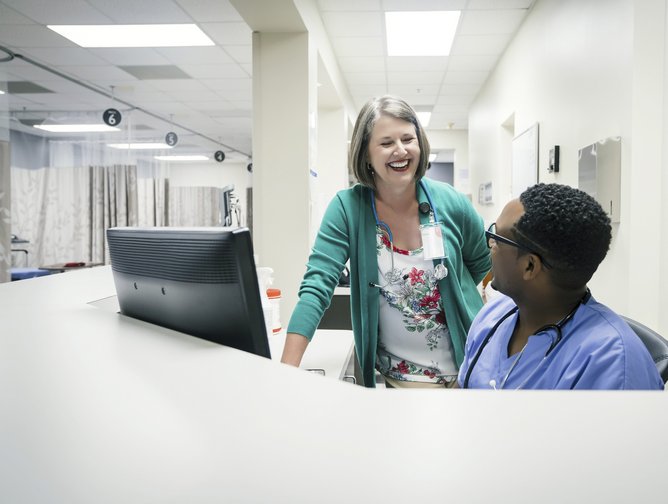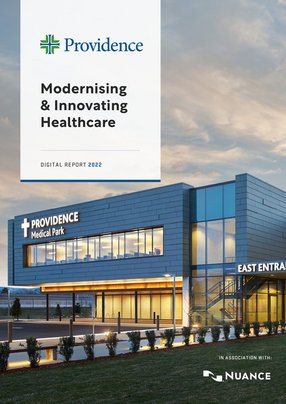Providence is a 165-year-old healthcare company and takes enormous pride in the fact that they were founded by women. Over the decades, they have grown immensely, combining the ministries of ‘Providence' and 'St. Joseph', while expanding through the acquisition of other health systems which has allowed them to be the US$25bn health system that they are today – and one of the largest health systems in the US.
As a whole and as individuals, each member of the team works to serve their communities in Alaska, Montana, Oregon, Washington California, Texas and New Mexico. Providence’s mission is to serve all, but especially the poor and the vulnerable, through their vision of 'Health for a Better World’.
“We primarily serve communities across seven states here on the west coast of the US, with 52 total hospitals and ministries, over 1000 clinics and 120,000 caregivers that serve those communities,” says B.J. Moore, CIO & EVP of Real-Estate Strategy Operations at Providence.
Moore has a professional career spanning 30 years, 27 of which were spent at Microsoft with roles in everything from finance and operations to IT. His last role at Microsoft was as the VP of engineering responsible for the company’s global commerce and compliance. After 27 years, ready to do something different and just as healthcare saw the rising need for digital transformation, Moore joined Providence as their Chief Information Officer (CIO). Since joining three years ago, he's also taken on their real-estate strategy and operations.
Moore’s role at Providence is twofold. As CIO, he owns the digital systems – everything from the networking infrastructure in their hospitals and ministries to all the systems they use for shared services such as payroll and financial systems, and the clinical systems that are used by their caregivers and patients – essentially covering most of the technology that's required to run, secure and modernise a health system. His other role is in real-estate strategy and operations, where his team is responsible for all the hospitals and clinics, as well as the building, maintenance and support of those buildings, including the cleaning of the hospital rooms.
“One thing I'm very proud of,” says Moore, “is that we received the very first known COVID patient in the United States, in January 20th 2020; and not only did we receive the first known patient (who was successfully treated), but we have served our communities very well throughout the entire pandemic. Our impact is huge.”
Simplify- Modernise- Innovate
When Moore joined Providence, he visited hospitals and ministries, and met with their administrative staff and caregivers. It became clear to him that healthcare was significantly behind other industries. “My estimate was 15-to-20 years behind,” says Moore. “And what came out of that learning tour were our three strategic pillars of 'simplify', 'modernise' and 'innovate'.”
Moore likes to think of these pillars in terms of Maslow's hierarchy of needs: at the bottom of the hierarchy sits 'simplify', which means simplifying the operating environment. At the time, for example, Providence had over 4,000 disparate computer applications, which hindered their ability to create a great patient and caregiver experience.
So the 'simplify' strategy looks at how Providence reduces that redundancy by transferring information on to a standardised set of platforms, while having just a few vital applications and processes to serve caregivers and patients.
'Modernise' sits in towards the middle of Maslow's hierarchy and concerns how to leverage modern technology and engineering practices to increase agility. This includes Providence’s decision to move from on-premise computing to the cloud, and implementing the use of collaborative tools like Microsoft Office and Teams, and the use of advanced delivery methods like Agile.
At the very top of the hierarchy occupying its capstone is 'innovate', which concerns the use of advanced computing like machine learning and artificial intelligence to push forward patient care and improve caregiver productivity.
Moore says: "It’s really hard to innovate at scale, and to sustain such innovation, if you have counterproductive complexities such as an environment with 4,000 applications, and significant “technological debt,” and that's why we first simplify the environment, then modernise the way that we use and deliver technology, which provides us with the foundation to innovate."
The problem: Employee Burnout
As Providence was the first health system to have received the first known COVID patient in the US, they have been under the intense strain of the pandemic for longer than any other US health system. Consequently, their caregivers – who had been on the frontline from the very beginning – were labouring under the long hours and days with no relief in sight.
As Providence caregivers were delivering COVID care to their communities there was, as we all know, a lot of non-COVID related care that was deferred. Finally, as COVID began to wane, these deferred patients began to stream into the system, which led to unprecedented caregiver burnout.
"Just like other health care systems in the country, we have seen a very high attrition rate and are now really short-staffed, which then reamplifies the level of caregiver burnout." The demand for care is higher than ever, but the staffing levels are lower than they were before COVID. "So what we are having to ask of our caregivers is unparalleled.”
The Solution: Alleviation and Empowerment through Technology, that eases the burden for frontline workers
With Providence's mission to serve all, especially the poor and vulnerable, this state of affairs means that they're struggling to meet community needs. Within this seemingly despondent situation, however, the use of technology has had a positive impact by alleviating the level of employee burnout through tools like Microsoft Teams, allowing Providence to adapt to the remote work environment where possible, and technologies like ambient artificial intelligence, to reduce the amount of administrative work for frontline caregivers.
Providence has built very strong partnerships with technology leaders such as Microsoft and Nuance, and through them, has access to vital technology with impressive consequences for their healthcare outcomes.
"Nuance has always been a trusted partner of ours," says Moore. Providence has used Nuance's tools, such as Dragon Medical One, for a long time - a speech recognition tool, which allows clinicians to dictate their notes using only their voice. "But what we're really partnering with them on is ambient clinical intelligence (DAX - Dragon Ambient eXperience)," he says. DAX allows a caregiver in a clinical setting to speak naturally with a patient, automatically documents the encounter and annotates it into the health record for the caregiver's edification.
Moore says: "This technology really allows for that natural interaction between a caregiver and a patient, and all that administrative work of adding information to the health record is done automatically, in the background."
What's more, this ambient tech is able to transform everyday language into professional medical terminology, where, for example, it may detect the words 'heart flutter' and automatically translate it into 'cardiac arrhythmia', or 'fast heartbeat' into 'tachycardia'.
There are several subsequent benefits to this technology. Firstly, it demonstrably increases productivity. But a more powerful effect is, that it allows for that natural interaction of the caregiver and patient, which is recognised in medical literature as having a significant positive impact on patient outcomes. "This allows the caregiver to practise their craft, which is, fundamentally, patient care and delivery," says Moore. "Our estimate is that a caregiver spends 40% to 60% of their time doing administrative work, so anything that we can do to relieve that burden is huge."
Providence, Nuance and Microsoft: A Triad of Excellence
Early this year, Nuance was acquired by Microsoft. Providence already had a strategic partnership with Microsoft, thus this acquisition really allows for Providence, Microsoft and Nuance to effectively have a strategic collaboration.
Providence is set to complete their simplification and modernisation journey by December 2022. They completed their move to a single electronic health record in March and, as of July, have moved to Oracle cloud, which is their new ERP system. Moore says: “Indeed, we’re under a lot of cost-pressure here in the US, and so the question is, ‘how do we provide those same services for less?’ We’ll focus on the efficiency of our own IT operations, and then the engineering work that we do is really going to be focused on caregiver attraction, retention and productivity.”
Providence is a shining example of the convergence occurring with tech and healthcare and should serve as an example for healthcare systems all over the globe, as to their ever-growing and inevitable interdependence.






